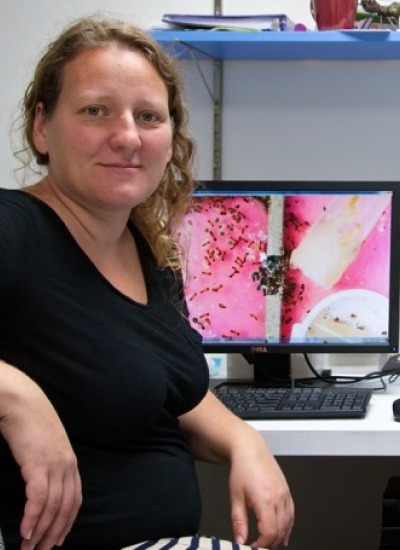Anna R Dornhaus
Publications
PMID: 14667335;PMCID: PMC1691524;Abstract:
We demonstrate a speed versus accuracy trade-off in collective decision making. House-hunting ant colonies choose a new nest more quickly in harsh conditions than in benign ones and are less discriminating. The errors that occur in a harsh environment are errors of judgement not errors of omission because the colonies have discovered all of the alternative nests before they initiate an emigration. Leptothorax albipennis ants use quorum sensing in their house hunting. They only accept a nest, and begin rapidly recruiting members of their colony, when they find within it a sufficient number of their nest-mates. Here we show that these ants can lower their quorum thresholds between benign and harsh conditions to adjust their speed-accuracy trade-off. Indeed, in harsh conditions these ants rely much more on individual decision making than collective decision making. Our findings show that these ants actively choose to take their time over judgements and employ collective decision making in benign conditions when accuracy is more important than speed.
PMID: 22872867;PMCID: PMC3427090;Abstract:
From microbes to humans, the success of many organisms is achieved by dividing tasks among specialized group members. The evolution of such division of labor strategies is an important aspect of the major transitions in evolution. As such, identifying specific evolutionary pressures that give rise to group-level division of labor has become a topic of major interest among biologists. To overcome the challenges associated with studying this topic in natural systems, we use actively evolving populations of digital organisms, which provide a unique perspective on the de novo evolution of division of labor in an open-ended system. We provide experimental results that address a fundamental question regarding these selective pressures: Does the ability to improve group efficiency through the reduction of task-switching costs promote the evolution of division of labor? Our results demonstrate that as task-switching costs rise, groups increasingly evolve division of labor strategies. We analyze the mechanisms by which organisms coordinate their roles and discover strategies with striking biological parallels, including communication, spatial patterning, and task-partitioning behaviors. In many cases, under high task-switching costs, individuals cease to be able to perform tasks in isolation, instead requiring the context of other group members. The simultaneous loss of functionality at a lower level and emergence of new functionality at a higher level indicates that task-switching costs may drive both the evolution of division of labor and also the loss of lower-level autonomy, which are both key components of major transitions in evolution.
Abstract:
A high-quality home can be a major factor determining fitness. However, when house hunting becomes necessary, animals might often face a speed-versus-accuracy trade-off and therefore be unable to survey their environment extensively for the optimum site. We found that the ant Leptothorax albipennis was able to correct errors made in such a hurried decision by continuing to survey even after a colony had settled in a nest site. Colonies moved from intact undisturbed nests to another nest site whenever the new nest site presented a sufficient improvement in nest quality. Thus, scout ants must be able to judge and compare the quality of the new, empty nest site with the one currently inhabited by the colony. Emigrations from intact nests were initiated by high numbers of ants recruited by tandem runs. This evidence may explain how a small number of scouts can motivate an entire colony to move when there is no immediate need to do so. Compared with their behaviour in emigrations from destroyed nests, the ants favoured even more strongly accuracy over speed, because they waited for a larger number of scouts to agree on one site before starting the emigration. They could do this without increased risk because the rest of the colony remained safely in the old nest. © 2004 The Association for the Study of Animal Behaviour. Published by Elsevier Ltd. All rights reserved.
Abstract:
Colony size can affect individual- and colony-level behavioral and physiological traits in social insects. Changes in behavior and physiology in response to colony growth and development can affect productivity and fitness. Here, we used respirometry to study the relationship between colony size and colony energy consumption in Temnothorax rugatulus ants. In addition, we examined the relationship between colony size and worker productivity measured as per capita brood production. We found that colony metabolic rate scales with colony size to the 0. 78 power and the number of brood scales with the number of workers to the 0. 49 power. These regression analyses reveal that larger ant colonies use proportionally less energy and produce fewer brood per worker. Our findings provide new information on the relationships between colony size and energetic efficiency and productivity in a model ant genus. We discuss the potential mechanisms giving rise to allometric scaling of metabolic rate in ant colonies and the influence of colony size on energy consumption and productivity in general. © 2012 International Union for the Study of Social Insects (IUSSI).


